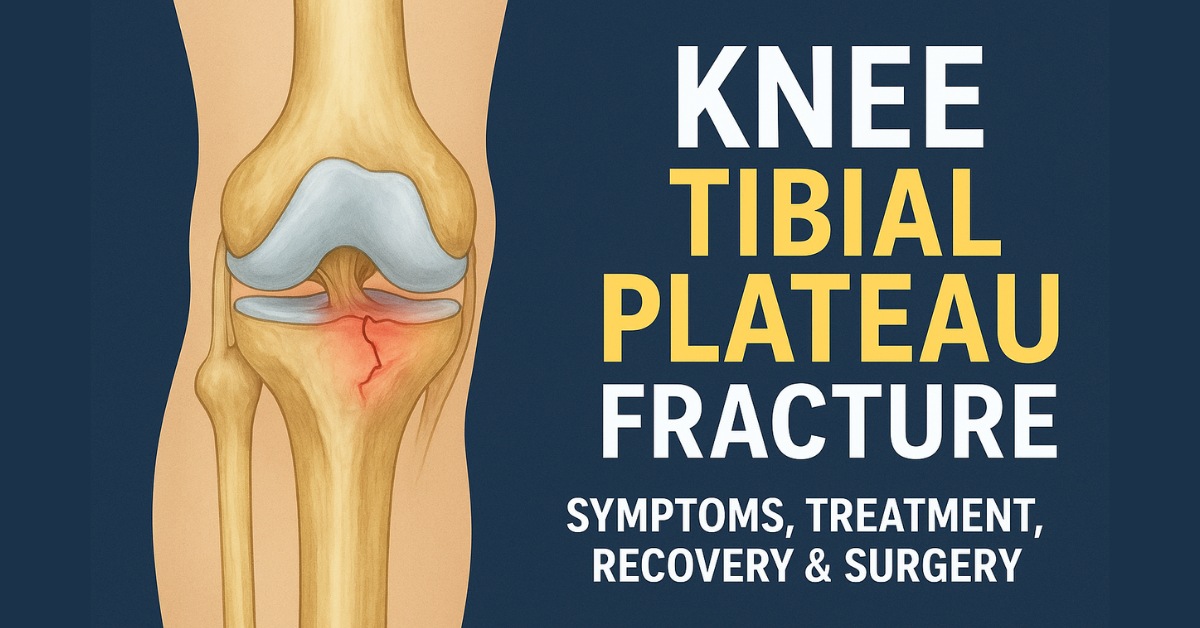A Knee tibial plateau fracture is a serious knee injury involving the top part of the tibia (shin bone) where it meets the knee joint. Because this area carries most of the body’s weight and supports movement, injuries here can impair walking, bending, and overall mobility.
This fracture is commonly seen in high-energy trauma like road traffic accidents (RTA), sports injuries, or falls from height. Older adults can also experience it from low-impact falls due to osteoporosis.
If not treated properly, tibial plateau fractures may lead to permanent knee instability, arthritis, and chronic pain. Early diagnosis and correct management are essential for good outcomes.
Understanding Knee Tibial Plateau Fracture Anatomy
The tibial plateau forms the bottom half of the knee joint, covered by cartilage, and supports:
- Body weight transmission
- Knee bending and rotation
- Stability during standing, walking, and running
A fracture here disrupts joint alignment and cartilage, which may lead to long-term joint damage if not treated well.
Common Causes of Knee Tibial Plateau Fracture
🚑 High-Energy Injuries
- Road traffic accidents
- Football, basketball, skiing injuries
- Fall from height
🧓 Low-Energy Injuries (especially in elderly)
- Slip on slippery floor
- Simple fall due to weak bones (Osteoporosis)
Symptoms & Signs to Watch For
| Symptom | Explanation |
|---|---|
| Severe knee pain | Instant and intense after injury |
| Swelling & bruising | Appears within hours |
| Inability to bear weight | Patient cannot stand or walk |
| Knee stiffness | Pain increases on bending |
| Deformity | Knee looks misaligned or sideways |
🚨 Medical Emergency Signs
- Numbness or tingling in foot
- Pale or cold leg
- Weak foot movement
These can indicate nerve or artery damage—seek urgent care!
Diagnosis
✅ 1. X-ray
Initial test to identify fracture and displacement
✅ 2. CT Scan
Best test for understanding fracture complexity and planning surgery
✅ 3. MRI (If needed)
To detect ligament, cartilage, and meniscus injury
Classification of Knee Tibial Plateau Fractures (Schatzker Classification)
| Type | Description |
|---|---|
| I | Lateral split fracture |
| II | Lateral split + depression |
| III | Pure depression fracture |
| IV | Medial plateau fracture |
| V | Both condyles fractured |
| VI | Dissociation of bone from shaft |
Type IV–VI are the most severe and often require surgery.
Treatment Options
✅ Non-Surgical (Conservative) Treatment
Suitable if fracture is not displaced
- Knee immobilizer/cast for 4–8 weeks
- No weight bearing initially
- Pain management
- Gradual physiotherapy
✅ Surgical Treatment
Required if there is:
✔ Displacement
✔ Joint surface damage
✔ Ligament injury
✔ Multiple fracture fragments
Surgical Procedure: ORIF (Open Reduction & Internal Fixation)
- Bone fragments realigned
- Plates & screws inserted to stabilize joint
Recovery Timeline
| Phase | Duration | Recovery Goals |
|---|---|---|
| Immobilization | 4–8 weeks | Pain reduction, no weight bearing |
| Physiotherapy begins | 6 weeks | Regain motion, reduce stiffness |
| Partial weight bearing | 8–12 weeks | Walk with support |
| Full recovery | 4–6 months | Normal walking & daily activity |
| Sports activity | 7–12 months | Only if doctor confirms |
Physiotherapy & Rehabilitation
Key exercises include:
- Leg raises (no knee bend)
- Knee bending stretches
- Hamstring and quadriceps strengthening
- Balance and gait training
Physiotherapy is as important as surgery—without it, stiffness and weakness may persist.
Possible Complications
⚠ Post-traumatic arthritis (most common)
⚠ Chronic knee pain
⚠ Limp or difficulty walking
⚠ Infection (post-surgery risk)
⚠ Knee stiffness or instability
Prevention Tips
- Use protective sports gear
- Avoid slippery floors
- Stay active to maintain bone strength
- Calcium + Vitamin D for strong bones
- Treat osteoporosis early in older adults
ICD-10 Code for Knee Tibial Plateau Fracture
| Condition | ICD-10 Code |
|---|---|
| Fracture of upper end of tibia | S82.14 |
❓Frequently Asked Questions (FAQs)
1. Can you walk with a Knee tibial plateau fracture?
No, most patients cannot walk or put weight on the knee due to severe pain and instability.
2. Does every Knee tibial plateau fracture need surgery?
No. Mild, non-displaced fractures may heal with casting and physiotherapy.
3. How long does recovery take?
Usually 4–6 months, complete recovery may take up to 1 year.
4. Is physiotherapy necessary?
Yes, it is essential to restore movement and prevent knee stiffness.
5. Can this cause arthritis?
Yes, if cartilage damage is present, post-traumatic arthritis may develop later in life.
6. What is the best scan for diagnosis?
CT scan is best for evaluating fracture structure and surgical planning.
Final Words
A Knee tibial plateau fracture is a serious knee joint injury but with timely diagnosis, proper treatment, and dedicated physiotherapy, most patients regain good function.
If you or someone has suffered a knee injury with swelling and inability to walk, seek urgent medical evaluation—early treatment makes all the difference in recovery and long-term mobility.
